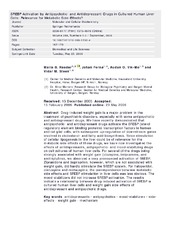| dc.description.abstract | The etiology of the serious psychiatric disorder schizophrenia is unknown. Epidemiological studies indicate a high heritability with a complex pattern of transmission. Moreover, structural and genetic findings indicate that both neuronal and glial function is affected, including oligodendrocyte and myelin abnormalities. Antipsychotic drugs are used to treat and ameliorate the symptoms of schizophrenia. Drug-mediated Dopamine D2-receptor blockage is probably necessary for reducing the positive symptoms (hallucinations, delusions) of schizophrenia, but the mechanism(s) involved in the improvement of other schizophrenic symptoms (negative and cognitive) are less well established. Unfortunately, there are several side effects associated with antipsychotic drug treatment, with increasing focus on weight gain and other metabolic adverse effects. To gain further insight into the mechanisms of antipsychotic drug action, we applied microarray technology and quantitative real-time PCR to investigate drug-induced changes in global gene expression in various cultured human cell lines, including glial-like cells, neuronlike cells and liver cells. We found that several typical and atypical antipsychotic drugs elevated the expression of genes involved in cellular lipid biosynthesis, including HMG-CoA reductase and fatty acid synthase that are essential enzymes in cholesterol- and fatty acid biosynthesis, respectively. These genes are controlled by the SREBP transcription factors, which we found activated by antipsychotic drugs on the protein level. The increase in gene expression had a functional outcome, as demonstrated by accumulation of intracellular cholesterol and triglycerides. Although with differences in efficacy, most of the tested antipsychotic drugs induced SREBP activation in cell culture. In our studies, the effect was more pronounced in glial cell lines than in neuronal-like cell lines. Antipsychotic-induced 10 SREBP activation was also seen in hepatocytes, indicating that clinically significant effects might occur in tissues other than the CNS. In a context of therapeutically relevant serum concentrations, clozapine and chlorpromazine appear as the most potent SREBP activators. Interestingly, clozapine has superior efficacy in otherwise treatment-resistent schizophrenia. Clozapine also has the highest liability to induce weight gain, and we further investigated the ability of clozapine to induce lipogenesis in vivo. Indeed, in rats exposed to a single intraperitoneal dose of clozapine we observed a marked increase in hepatic lipid levels and altered expression of several genes involved in the control of lipid homeostasis (e.g. SREBP, PPARα and LXRα). In summary, we have identified transcriptional activation of cellular lipogenesis as a new mechanism of action of antipsychotic drugs. Enhanced cholesterol synthesis in the CNS may have therapeutic implications (glia-produced cholesterol serves as a glial growth factor to promote synaptogenesis and myelination), whereas increased lipid production in the liver and adipose tissues may be linked to the well-known metabolic side effects of these drugs. We propose that our findings provide new insight into the molecular mechanisms of antipsychotic drugs and provide new candidate genes for disease susceptibility and drug response in schizophrenia. | en_US |



